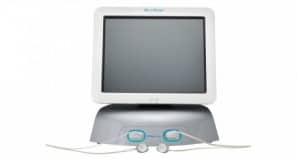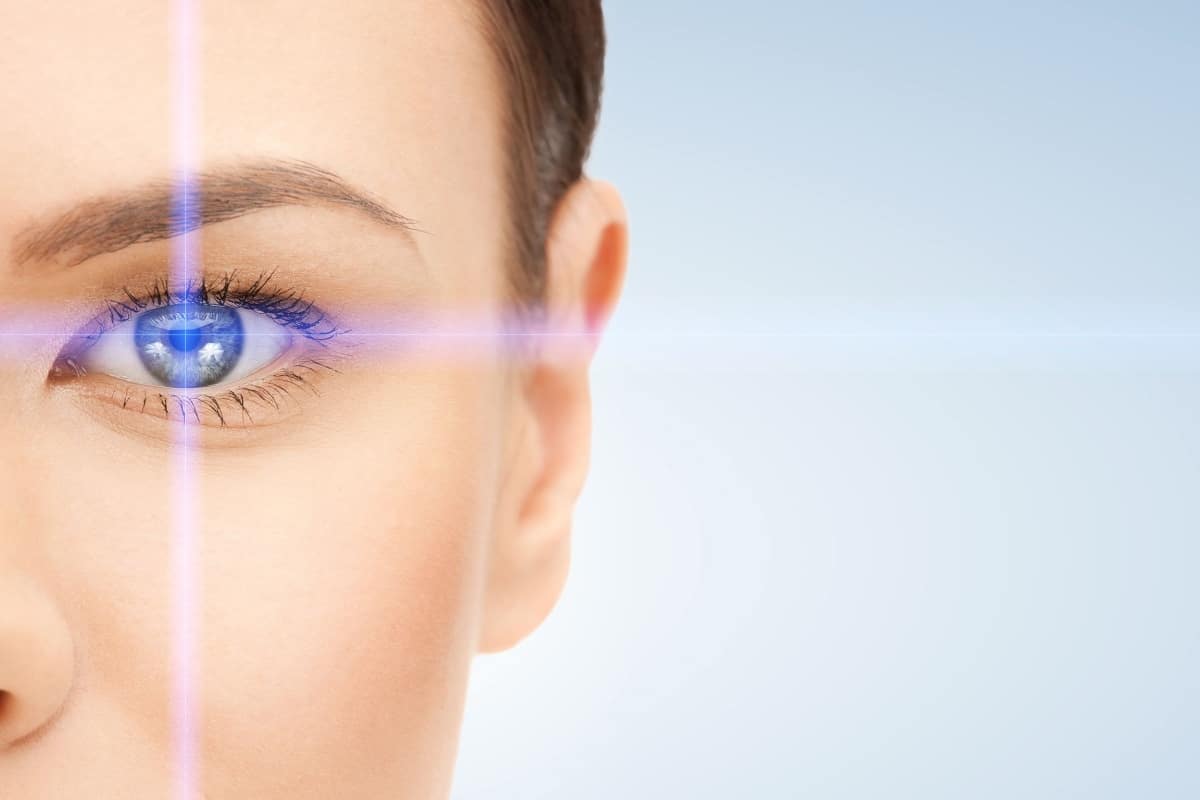Dry eye (often called dry eye disease or dry eye syndrome) is one of the most under-diagnosed ocular diseases, and it is one of the most common reasons why patients go see their eye care professional. Eye Clinic of Austin is a TearLab Accredited Dry Eye Center and utilizes the most advanced technology on the market to diagnose and treat dry eyes, including LipiView® and LipiFlow®.
To get started right away, please schedule a dry eye assessment.
What is Dry Eye?
 There are two main forms of dry eye, evaporative dry eye and aqueous deficient dry eye. Many people mistake the dry eye symptoms for allergies, climatic conditions or just eyestrain. While all of these may aggravate dry eye symptoms, they are not the cause.
There are two main forms of dry eye, evaporative dry eye and aqueous deficient dry eye. Many people mistake the dry eye symptoms for allergies, climatic conditions or just eyestrain. While all of these may aggravate dry eye symptoms, they are not the cause.
Evaporative Dry Eye
Evaporative dry eye accounts for 86% of all dry eye cases and occurs when a person’s Meibomian glands are blocked. Meibomian glands are located in the eyelids and this condition of obstructed glands is known as Meibomian Gland Dysfunction (MGD). When functioning properly, the Meibomian glands create a lipid (oil) layer of tears. Without this tear film oil, an individual’s tears can evaporate four to sixteen times faster causing discomfort and dryness, thus the name evaporative dry eye.
Aqueous Deficient Dry Eye
Aqueous deficient dry eye occurs when the lacrimal glands do not produce a sufficient amount of aqueous (water) to keep the eyes moist. In aqueous deficient dry eye, underlying changes to these tear-producing glands result in a lower quantity of tears being made and not enough water reaches the surface of the eye.
Both evaporative dry eye and aqueous deficient dry eye can lead to damage of the eyes’ surface, which, in turn, can lead to the symptoms of dry eye. Reduced tear production over a long period of time increases the risk of permanent damage and scarring to the front of the eye.
Causes
Dry eye can be caused by multiple different factors including:
Environmental Causes
Changes in environment can cause dry eye such as hot, dry and/or windy climates, high altitudes, excessive sun exposure, central heating, air conditioning, hair dryers, cigarette smoke, air pollution, and air travel.
Medications (prescription or over the counter)
Many medications can cause dry eye. These medications can include allergy medications, especially antihistamines, antidepressants (Amitriptyline, Diazepam), some blood pressure medications, Parkinson’s medications, birth control pills, diuretics, beta blockers, sleeping pills, many pain medications, certain medications which regulate heart rhythm irregularities, and decongestants.
Contact Lens Wear
Wearing contact lenses while sleeping when the lenses are not designed for that type of wear can be a cause of dry eye. In addition, wearing the lenses for a longer period of time than they are designed for can also cause this issue. An example would be wearing 2-week disposable contact lenses for longer than that 2-week period.
Non Eye-Related Diseases
Individuals with Parkinson’s disease, Sjögren’s syndrome (an auto-immune disease), Rheumatoid arthritis, Lupus, Lacrimal gland deficiency, Diabetes, Sarcoidosis, Stevens-Johnson syndrome, or Rosacea can experience dry eye.
Refractive Eye Surgery
After LASIK, some individuals do experience dry eye.
Hormonal Deficiencies or Changes
Thyroid conditions, hormonal changes during menopause, decreased production of androgen, and estrogen supplementation can cause dry eye.
Low blink rate
Blinking is critical in spreading tears over the surface of the eye and stimulating tear production. A chronic low blink rate is associated with dry eye symptoms. Computer use, reading, and watching TV are the three activities most commonly associated with a low blink rate.
Symptoms & Diagnosis
Symptoms of dry eyes may include stinging, burning, scratchy sensation, sensitivity to light, tearing, tired eyes, and difficulty wearing contact lenses. In addition, many patients suffer from blurred vision, often worsening at the end of the day or after visually focusing for a prolonged period on a nearby task.
The first step in dry eye diagnosis is to schedule a dry eye assessment to diagnose the disease. At Eye Clinic of Austin, we use a couple of different devices to diagnosis dry eye and the severity of the disease including the TearLab® Osmolarity test and the LipiView test.
TearLab Osmolarity Test
 The TearLab Osmolarity test is a painless process which tests a tiny tear sample to measure osmolarity (salt content) in the tears. Tear osmolarity has been shown to have one of the best predictive values of any single test for diagnosing dry eye disease. The test provides our eye doctors a meaningful measure of the health and stability of the protective tear film that covers the surface of your eyes.
The TearLab Osmolarity test is a painless process which tests a tiny tear sample to measure osmolarity (salt content) in the tears. Tear osmolarity has been shown to have one of the best predictive values of any single test for diagnosing dry eye disease. The test provides our eye doctors a meaningful measure of the health and stability of the protective tear film that covers the surface of your eyes.
LipiView Test
 The LipiView device takes extremely detailed images of your eye’s tear film allowing the physician to evaluate the lipid (oil) layer on your eye. This non-invasive test takes less than five minutes and the patient will see their tear film as an array of colors that are reflected when a light source is directed towards the front surface of the eye.
The LipiView device takes extremely detailed images of your eye’s tear film allowing the physician to evaluate the lipid (oil) layer on your eye. This non-invasive test takes less than five minutes and the patient will see their tear film as an array of colors that are reflected when a light source is directed towards the front surface of the eye.
Treatment
Eye Clinic of Austin offers many advanced treatments to help patients experience relief from dry eye. Our eye doctors prescribe custom therapies depending on the type of dry eye a patient is experiencing. These therapies may include lubricating the eye with topical artificial tears, a prescription eye drop, TrueTear®, or LipiFlow treatment.
TrueTear® Treatment
 We’re pleased to announce that TrueTear® is now available at Eye Clinic of Austin. If you feel like your eyes aren’t making enough tears, our Eye Care Providers and you can decide together if TrueTear® could be right for you. TrueTear® is a device that uses state-of-the-art technology called neurostimulation to help your eyes temporarily make more of your own tears.
We’re pleased to announce that TrueTear® is now available at Eye Clinic of Austin. If you feel like your eyes aren’t making enough tears, our Eye Care Providers and you can decide together if TrueTear® could be right for you. TrueTear® is a device that uses state-of-the-art technology called neurostimulation to help your eyes temporarily make more of your own tears.
TrueTear® Highlights
- Drop-free, drug-free option
- Prescription only
- Fits into your daily routine.
Learn more at truetear.com.
We are excited to be among a select group of practices offering TrueTear®. Contact our office today to schedule a TrueTear® demo during your next appointment.
LipiFlow Treatment
The LipiFlow Thermal Pulsation System by TearScience® is the first and only treatment that addresses the cause of evaporative dry eye: blocked Meibomian glands. For individuals who have tried to alleviate symptoms with eye drops and warm compresses, LipiFlow treatment may be the key for sustained relief from dry eye.
The LipiFlow relieves Meibomian gland blockage by applying a combination of directed heat and pulsation pressure. The LipiFlow Activator (a disposable eyepiece) is inserted under the lower and upper eye lid and is shaped to prevent contact with the cornea. Once in place, the patient simply reclines in the treatment chair for the 12 minute procedure.
Think of it as a “spa treatment” for your eyes. Gentle heat and light pressure create a warm massage that stimulates the Meibomian glands’ natural lipid production and helps restore the balance disrupted by evaporative dry eye. Opening and clearing these blocked glands can allow them to resume natural production of lipids (oils) needed for a healthy tear film. Four weeks after a single LipiFlow procedure, 79% of patients reported an improvement in overall dry eye symptoms.



Hear from Cat G. about her experience with LipiFlow at Eye Clinic of Austin, “I have suffered from Dry Eye for years and have used every type eye drop in the book including prescriptions, and used warm compresses, but the relief was only temporary and nothing seemed to take the red out. Early in 2014 the symptoms became so unbearable that I started searching the internet for anything that might help. I saw the Lipiflow treatment at the Eye Clinic of Austin’s website and made an appointment. Dr. Henderson said I was a good candidate for the procedure because my dry eye symptoms were the worst he has seen, so the procedure was set for July 1. They weren’t kidding when they said the Lipiflow treatment was “spa-like”. The gentle pulsing and warm sensation was very soothing to my eyes and I actually wished it lasted longer than 12 minutes! Today I went in for my 2 week follow-up and I was pleased to tell Dr. Henderson that I felt like I had new eyes! Prior to the Lipiflow treatment my eyes hurt constantly, were even worse in the evenings and so heavy it was hard to keep them open. . . and my eyes were always bright red. NOW, they feel only mildly irritated and that is only after 2 weeks. I can even see the whites of my eyes now! If the treatment showed such a drastic improvement to my eyes in such a short time, just imagine how quickly it will help someone with less severe symptoms.”
If you are interested in meeting with one of our ophthalmologists about treatment options for dry eye, please request a dry eye assessment.
Testimonials
Eye Care Blog

Ensuring the health and well-being of our eyes demands careful attention and proactive measures. Among the most critical actions we can take is the use of sunglasses to shield our eyes from the sun’s damaging UV rays. This simple yet effective strategy plays a pivotal role in preventing potential harm and preserving our eye health […]

Prevent Eye Injuries This Spring with Protective Eyewear Spring welcomes warmer weather and longer days, enticing many to indulge in outdoor activities. However, this season also poses potential risks for eye injuries. Understanding the significance of protective eyewear is crucial for those with sensitive eyes. At Eye Clinic of Austin, our team is committed […]

In an evolving healthcare landscape, in-office surgery has become an appealing alternative to traditional hospital-based procedures, particularly for patients seeking quality eye care and various eye surgeries, such as corneal transplants or treatment for glaucoma. At Eye Clinic of Austin, our skilled eye doctors address concerns that are related to a range of eye conditions […]






